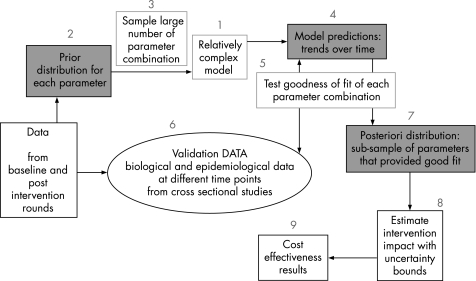Figure 2 Flowchart of the different stages of the mathematical framework described in the main text. Baseline and postintervention rounds of integrated behavioural and biological assessments, special behavioural surveys and general population surveys (see supplementary fig S1) as well as complementary data from literature reviews or other sources (table 1) will help to define biological, demographic and intervention before parameter distribution (stage 2) and to validate model results (stage 6). Ideally, baseline data are collected just before the intervention starts. In districts where these data are not available, the first round of data, even if collected after the start of the intervention, will be used as baseline for the main impact assessment, even if this leads to more conservative estimates. The magnitude of underestimation will, however, be assessed after defining a proxy baseline dataset based on literature reviews of published reports, scientific papers of representative samples of high‐risk and general populations, surveys of non‐governmental organisations, which gathered information on the level of condom use and sexual behaviour at the beginning of the programme, and early independent surveys in different districts. These will be complemented by information on behaviour among unexposed individuals in the first round survey (see supplementary fig S2). Supplementary figures are available on the STIwebsite: http://sti.bmj.com/.

An official website of the United States government
Here's how you know
Official websites use .gov
A
.gov website belongs to an official
government organization in the United States.
Secure .gov websites use HTTPS
A lock (
) or https:// means you've safely
connected to the .gov website. Share sensitive
information only on official, secure websites.
